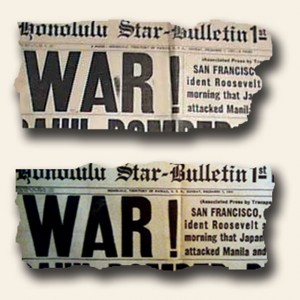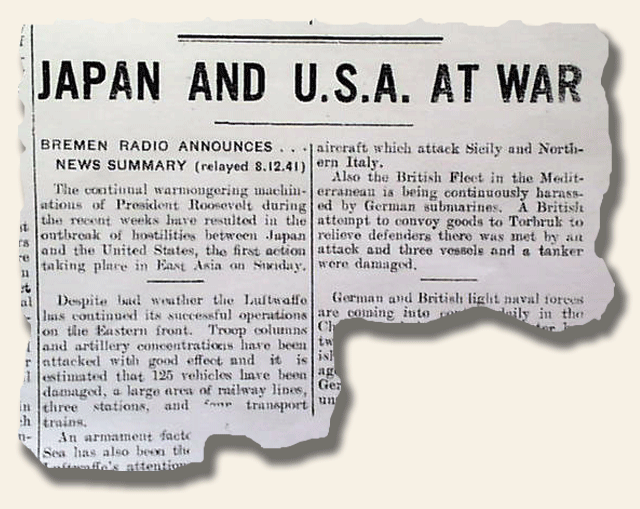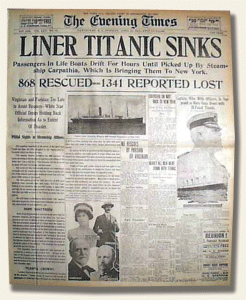The Attack on Pearl Harbor… Great Headlines Speak For Themselves…
February 18, 2016 by GuyHeilenman · Leave a Comment
The best headlines need no commentary. Such is the case with the HONOLULU STAR BULLETIN – 1st Extra! printed on December 7, 1941:
The Last Surviving Veterans Who Served at Pearl Harbor…
October 22, 2015 by GuyHeilenman · Leave a Comment
Collecting World War II era newspapers covering significant events continues to be popular among collectors, even though the number of WWII veterans continues to decline. Authentic issues of the Honolulu Star-Bulletin reporting the Pearl Harbor tragedy certainly stand above them all. It is with this in mind we are pleased to post the following article compliments of Francisco Mesa.
The Last Surviving Veterans Who Served at Pearl Harbor
As the years roll by, the list of surviving US veterans of WWII who served at Pearl Harbor when the Japanese Navy attacked the US Navy’s Pacific Fleet inevitably becomes shorter. And with the Pearl Harbor survivors well past their late 80s and some passing even the ripe-old century mark, their numbers are dwindling rapidly all over the US. Last year, just about 2,000 survivors were thought to be around, still.
National Pearl Harbor Remembrance Day
On December 7, 2014, the US President Barrack Obama designated December 7 as the National Pearl Harbor Remembrance Day. Four veterans of the remaining 9 USS Arizona survivors gathered at the Pearl Harbor Visitor Center on December 7, 2014, for a meeting of USS Arizona survivors. The veterans were greeted by music and military salutes from the US Navy Band. Later, they viewed a live feed of an underwater dive beside USS Arizona’s sunken hull that still holds over 900 bodies. For the veterans, each return to Pearl Harbor brings back intense and, sometimes, painful memories.
USS Arizona Reunion Association’s Last Gathering at Hawaii
Although it was the last formal survivor gathering of the erstwhile USS Arizona Reunion Association at Hawaii, the veterans said they still intend to get together—if not in Hawaii, somewhere in the US. Louis Conter, 93, felt he still had some time, and he’d come back to the Pearl Harbor Visitor Center regardless of who else makes it.
Donald Stratton, USS Arizona Survivor
Donald Stratton, 92, of Colorado is another USS Arizona survivor. Don Stratton had been manning the Anti-Aircraft gun batteries. He remained at his battle station on the ship’s port side until the last possible moment. He endured 65 percent burns and a one-year hospitalization. Stratton was medically discharged from the US Navy but re-enlisted a year later. He said that the good Lord saved a precious few from the USS Arizona.
John Anderson, USS Arizona Survivor
John Anderson, 97, was ordered off the USS Arizona, but he wasn’t willing to leave behind his twin brother, Delbert. Although Anderson was forced into a boat and packed off to the safer Ford Island, he returned in an empty boat and rescued three shipmates. Sadly, he didn’t find his brother. Anderson recalled that he had just attended church services that day and had been heading to breakfast when someone warned that the Japanese planes were coming.
Anderson Recalls the Harrowing Experience
Anderson remembers lying in a bomb-blast crater on Ford Island after the surprise attack. He had picked up a rifle and two bandoliers of ammunition and started firing at Japanese aircraft. Anderson had hunkered there through that night with another sailor. In the morning, a passing Marine patrol informed him that survivors of the USS Arizona had to gather at the dock nearby to facilitate a head count. Anderson remembers everyone he saw having rags around their heads. He clearly recalls bandages covered their arms and their skin had been scorched, and their hair had been burned off.
Lauren Bruner, USS Arizona Survivor
Lauren Bruner, 94, had been alongside Don Stratton manning his battle station. There were four others as well. Bruner had escaped from the fiery, sinking battleship by shimmying across a rope that dangled 60 feet above Pearl Harbor’s waters. Bruner had been standing just 70 feet from the spot the torpedo bomb had exploded at the USS Arizona’s forward magazine. He suffered almost 75 percent burns. But that didn’t deter him. Bruner and his comrades were intent on fighting back. There was only one thing that hampered them … they just had to survive the next few moments. So, after catching the attention of one sailor aboard the warship moored alongside their own, a rope stretching almost 100 feet was thrown across.
The Sailors’ Great Escape from the Burning USS Arizona
All the 6 men made the painful—all of them had suffered serious burns—hand-over-hand escape. They had dangled 60 feet in the air as huge flames rising from the oily harbor had burned their skin even more. Bruner had been the second last to leave USS Arizona. Alvin Dvorak, the last one to escape over the rope, had been the one that caught the attention of the sailor on the USS Vestal. Unfortunately, Dvorak succumbed after spending 17 days in the hospital. He had suffered 84 percent burns. Lauren Bruner considers Alvin Dvorak to be the true hero of their great escape. Bruner spent the next seven months in the hospital and returned to the Pacific theater.
Conclusion
Although the survivors of Pearl Harbor are in their early or mid 90s, they can recall the Japanese sneak attack vividly. Many of the survivors fondly hope to live long enough to attend the 75th anniversary of the Pearl Harbor strike in Hawaii on December 7, 2016.
If you are ever visit Hawaii, there are several Pearl Harbor tours that range from just a couple hours to a full day. There are still droplets of oil coming out of the sunken battleship USS Arizona. Also, there are hundreds of people still entombed within the sunken battleship. It is said that the droplets of oil represent the crying of the fallen men and women. And when the droplets of oil stop, the crying will stop.
© Francisco Meza
The Battle of Los Angeles…
March 14, 2014 by TimHughes · 2 Comments
 The “Los Angeles Times–Extra” of February 24, 1942 has one of the more dramatic, screaming headlines to be found in any newspaper: “L.A. AREA RAIDED ! ” with a smaller head noting: “Jap Planes Peril Santa Monica, Seal Beach, El Segundo, Redondo, Long Beach, Hermosa, Signal Hill”. The report begins: “Roaring out of a brilliant moonlit western sky, foreign aircraft flying both in large formation and single, few over Southern California early today and drew heavy barrages of anti-aircraft fire–the first ever to sound over United States continental soil against an enemy invader…” (see).
The “Los Angeles Times–Extra” of February 24, 1942 has one of the more dramatic, screaming headlines to be found in any newspaper: “L.A. AREA RAIDED ! ” with a smaller head noting: “Jap Planes Peril Santa Monica, Seal Beach, El Segundo, Redondo, Long Beach, Hermosa, Signal Hill”. The report begins: “Roaring out of a brilliant moonlit western sky, foreign aircraft flying both in large formation and single, few over Southern California early today and drew heavy barrages of anti-aircraft fire–the first ever to sound over United States continental soil against an enemy invader…” (see).
The Battle of Los Angeles, also known as The Great Los Angeles Air Raid, is the name given to this rumored enemy attack and subsequent anti-aircraft artillery barrage which took place from late February 24 to early February 25, 1942 over Los Angeles. The incident occurred less than three months after the United States entered World War II as a result of the Japanese Imperial Navy’s attack on Pearl Harbor.
Initially, the target of the aerial barrage was thought to be an attacking force from Japan, but speaking at a press conference shortly afterward, Secretary of the Navy Frank Knox called the incident a “false alarm.” Newspapers of the time published a number of reports and speculations of a cover-up. Some modern-day UFOlogists have suggested the targets were extraterrestrial spacecraft. When documenting the incident in 1983, the U.S. Office of Air Force History attributed the event to a case of “war nerves” likely triggered by a lost weather balloon and exacerbated by stray flares and shell bursts from adjoining batteries.
Air raid sirens sounded throughout Los Angeles County on the night of February 24-25, 1942. A total blackout was ordered and thousands of air raid wardens were summoned to their positions. At 3:16 am the 37th Coast Artillery Brigade began firing .50 caliber machine guns and 12.8-pound anti-aircraft shells into the air at reported aircraft; over 1,400 shells would eventually be fired. Pilots of the 4th Interceptor Command were alerted but their aircraft remained grounded. The artillery fire continued sporadically until 4:14 am. The “all clear” was sounded and the blackout order lifted at 7:21 am.
Several buildings and vehicles damaged by shell fragments, and five civilians died as an indirect result of the anti-aircraft fire, three of them killed in car accidents in the ensuing chaos and two of heart attacks attributed to the stress of the hour-long action. The incident was front-page news along the U.S. Pacific coast, and earned some mass media coverage throughout the nation.(credit to Wikipedia)
#25 – Best of the 20th century? (*revisited)
January 3, 2014 by GuyHeilenman · Leave a Comment
As newspaper collectors we dream of “the event” we’d like to add to our collection. It’s the search for that issue–or issues–which make this a fascinating hobby. This is, after all, a very visual hobby. How displayable are stamps and coins? Huge headlines proclaiming a cataclysmic event or magnificent achievement lend themselves so well to display, much more so than an original document about the event.
The 20th century had a great wealth of interesting events. But what is the best? If you could only make one choice, what single headline of the 20th century would you most want to see in your collection?
I wrestle with how to approach this thought: most life-altering? most recognizable? most historic? most appealing for display? I believe the first Wright brothers’ flight is the most life-altering; “Dewey Defeats” Truman” as the most recognizable; and a great “Titanic Sinks” report as the most displayable. Some newspapers did much with the events of the gangster era, and certainly the “careers” of Bonnie & Clyde, John Dillinger and Al Capone are well known and significant reports would be attention-grabbers on any wall. On a more positive note there are some spectacular “V-E Day” and “V-J Day” issues celebrating the end of World War II. But limiting myself to just a single issue I would take “Titanic Sinks”. ….what’s your thought?
*The Fall of 2013 marked the 5th anniversary of the History’s Newsstand Blog by Timothy Hughes Rare & Early Newspapers. We are grateful to have the opportunity to contribute to the newspaper collecting community, and appreciate those who have participated through guest posts, comments, and readership. In 2014 we will revisit the top 25 posts (measured by activity), with the number 1 post being revisited during the first week of 2015. Please enjoy. If you would like to contribute a post for consideration of inclusion on the blog, please contact Guy Heilenman at guy@rarenewspapers.com.
The reprint issues of the “Honolulu Star-Bulletin” Pearl Harbor issue…
May 14, 2012 by TimHughes · 30 Comments
 If there is a second in line for the most common phone call or email about a newspaper which turns out to be a reprint, it would be the December 7, 1941 of the “Honolulu Star-Bulletin – 1st Extra“.
If there is a second in line for the most common phone call or email about a newspaper which turns out to be a reprint, it would be the December 7, 1941 of the “Honolulu Star-Bulletin – 1st Extra“.
The genuine issue is arguably the best newspaper to have reporting the historic bombing of Pearl Harbor, being a dramatic headline, from the day it happened, and from where it happened. And consequently those conditions make it ripe for creating a reprint edition. From what I understand the reprints are still available at the souvenir shop at the Pearl Harbor memorial.
There are a couple of tell-tale indicators which are easily observed:
* The genuine issue has an ink smear between the “A” and “R” in the huge “WAR ! ” in the headline.
* The reprint edition does not have the ink smear, it having been “cleaned up” to make for a better appearance.
* The genuine “1st Extra” is 8 pages and does not have the “2nd Extra” nor the “3rd Extra” within, as they were separate, stand-alone edition printed later in the day. The reprint editions typically have one of both of the later editions on pages 3 and/or 5.
* At least one of the reprint edition has the front page of the “Honolulu Advertiser” newspaper on page 3. Obviously a competing newspaper’s front page would not be found within a genuine issue of the “Star-Bulletin”.
As if the above are not sufficient in determine a genuine from reprint edition, the photos of the reprints typically have a “muddy” appearance and are not as crisp & clear as would be found in the genuine issue.
Roosevelt to blame for the Pearl Harbor attack…
October 16, 2010 by TimHughes · Leave a Comment
We often list on our website issues from the island of Guernsey during World War II when it was occupied by the Nazis. As such all news is filtered through the German propaganda machine which offers interesting reading, as the reports are in English because the residents speak English.
Although many battles reports border on the absurd, particularly with historical hindsight, the front page report in the “Evening Press” dated December 8, 1941, one day after the Pearl Harbor attack, is one of the more outrageous (see the photo below).
Prices realized… 20th century…
September 27, 2010 by GuyHeilenman · 1 Comment
We continue with our series on “prices realized”, with this 4th installment providing select examples of issues from the 20th century. While there are many issues to choose from, we tried to cover a variety of collectible interests.
 Note: While collectible newspapers have had a good track record of increasing in value over time (see upcoming posts), we encourage hobbyists to collect for non-financial reasons. History in your hands…
Note: While collectible newspapers have had a good track record of increasing in value over time (see upcoming posts), we encourage hobbyists to collect for non-financial reasons. History in your hands…
20th century selections:
The previous posts in this series are:
Prices realized… 16th & 17th centuries…
Prices realized… 18th century…
Prices realized… 19th century…




